
Barbara Bombi, Anglo-Papal Relations in the Early Fourteenth Century: A Study in Medieval Diplomacy (Oxford Univ. Press, 2019)
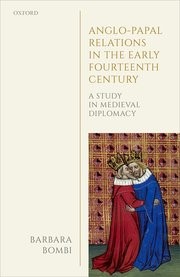
This volume is concerned with diplomacy between England and the papal curia during the first phase of the Anglo-French conflict known as the Hundred Years’ War (1305-1360). On the one hand, Barbara Bombi compares how the practice of diplomacy, conducted through both official and unofficial diplomatic communications, developed in England and at the papal curia alongside the formation of bureaucratic systems. On the other hand, she questions how the Anglo-French conflict and political change during the reigns of Edward II and Edward III impacted on the growth of diplomatic services both in England and the papal curia.
Through the careful examination of archival and manuscript sources preserved in English, French, and Italian archives, this book argues that the practice of diplomacy in fourteenth-century Europe nurtured the formation of a “shared language of diplomacy”. The latter emerged from the need to “translate” different traditions thanks to the adaptation of house-styles, formularies, and ceremonial practices as well as through the contribution of intermediaries and diplomatic agents acquainted with different diplomatic and legal traditions. This argument is mostly demonstrated in the second part of the book, where the author examines four relevant case studies: the papacy’s move to France after the election of Pope Clement V (1305) and the succession of Edward II to the English throne (1307); Anglo-papal relations between the war of St Sardos (1324) and the deposition of Edward II in 1327; the outbreak of the Hundred Years’ Wars in 1337; and lastly the conclusion of the first phase of the war, which was marked in 1360 by the agreement between England and France known as the Treaty of Brétigny-Calais.
Rachel Fulton Brown, Mary and the Art of Prayer: The Hours of the Virgin in Medieval Christian Life and Thought (Columbia Univ. Press, 2019)

Would you like to learn to pray like a medieval Christian? In Mary and the Art of Prayer, Rachel Fulton Brown traces the history of the medieval practice of praising Mary through the complex of prayers known as the Hours of the Virgin. More than just a work of comprehensive historical scholarship, the book asks readers to immerse themselves in the experience of believing in and praying to Mary. Mary and the Art of Prayer crosses the boundaries that modern scholars typically place between observation and experience, between the world of provable facts and the world of imagination, suggesting what it would have been like for medieval Christians to encounter Mary in prayer.
Mary and the Art of Prayer opens with a history of the devotion of the Hours or “Little Office” of the Virgin. It then guides readers in the practice of saying this Office, including its invitatory (Ave Maria), antiphons, psalms, lessons, and prayers. The book works on several levels at once. It provides a new methodology for thinking about devotion and prayer; a new appreciation of the scope of and audience for the Hours of the Virgin; a new understanding of how Mary functions theologically and devotionally; and a new reading of sources not previously taken into account. A courageous and moving work, it will transform our ideas of what scholarship is and what it can accomplish.
Orazio Condorelli and Rafael Domingo, eds., Law and the Christian Tradition in Italy: The Legacy of the Great Jurists (Law and Religion) (Routledge, 2020)
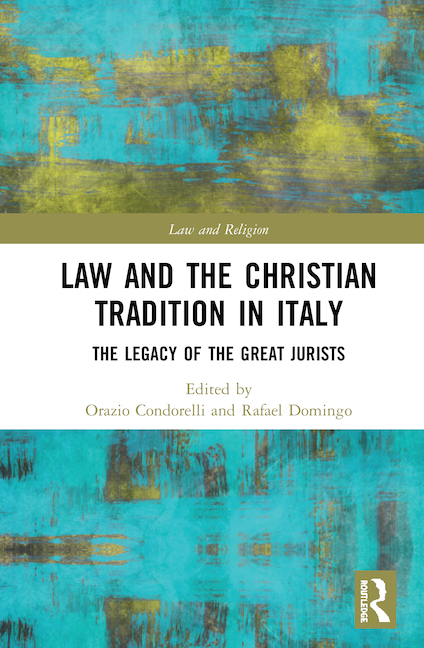
Firmly rooted on Roman and canon law, Italian legal culture has had an impressive influence on the civil law tradition from the Middle Ages to present day, and it is rightly regarded as “the cradle of the European legal culture.” Along with Justinian’s compilation, the US Constitution, and the French Civil Code, the Decretum of Master Gratian or the so-called Glossa ordinaria of Accursius are one of the few legal sources that have influenced the entire world for centuries.
This volume explores a millennium-long story of law and religion in Italy through a series of twenty-six biographical chapters written by distinguished legal scholars and historians from Italy and around the world. The chapters range from the first Italian civilians and canonists, Irnerius and Gratian in the early twelfth century, to the leading architect of the Second Vatican Council, Pope Paul VI. Between these two bookends, this volume offers notable case studies of familiar civilians like Bartolo, Baldo, and Gentili and familiar canonists like Hostiensis, Panormitanus, and Gasparri but also a number of other jurists in the broadest sense who deserve much more attention especially outside of Italy. This diversity of international and methodological perspectives gives the volume its unique character.
The book will be essential reading for academics working in the areas of Legal History, Law and Religion, and Constitutional Law and will appeal to scholars, lawyers, and students interested in the interplay between religion and law in the era of globalization.
David L. D’Avray, Dissolving Royal Marriages: A Documentary History, 860–1600 (Cambridge Univ. Press, 2017)
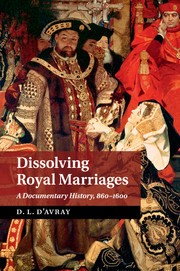
Dissolving Royal Marriages adopts a unique chronological and geographical perspective to present a comparative overview of royal divorce cases from the Middle Ages through to the Reformation period. Drawing from original translations of key source documents, the book sheds new light on some of the most prominent and elite divorce proceedings in Western history, including Henry VIII’s divorce from Catherine of Aragon. The comprehensive commentary that accompanies these materials allows readers to grasp, for the first time, how the constructs of canon law helped shape the legal arguments on which specific cases were founded, and better understand the events that actually unfolded in the courtrooms. In his case-by-case exploration of elaborate witness statements, extensive legal negotiations and political wrangling, d’Avray shows us how little the canonical law for the dissolution of marriage changed over time in this fascinating new study of Church-state relations and papal power over princes.
David L. D’Avray, Papacy, Monarchy and Marriage 860–1600 (Cambridge Univ. Press, 2017)
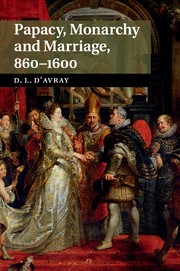
This analysis of royal marriage cases across seven centuries explains how and how far popes controlled royal entry into and exits from their marriages. In the period between c.860 and 1600, the personal lives of kings became the business of the papacy. d’Avray explores the rationale for papal involvement in royal marriages and uses them to analyse the structure of church-state relations. The marital problems of the Carolingian Lothar II, of English kings – John, Henry III, and Henry VIII – and other monarchs, especially Spanish and French, up to Henri IV of France and La Reine Margot, have their place in this exploration of how canon law came to constrain pragmatic political manoeuvring within a system increasingly rationalised from the mid-thirteenth century on. Using documents presented in the author’s Dissolving Royal Marriages, the argument brings out hidden connections between legal formality, annulments, and dispensations, at the highest social level.
David L. D’Avray, Papal Jurisprudence, 385-1234: Social Origins and Medieval Reception of Canon Law (Cambridge Univ. Press, 2022)
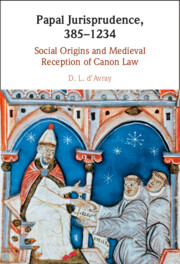
Why did bishops turn to the papacy for advice in late Antiquity? And what does the reception of these decretals reveal about the legal and religious culture of the mid-thirteenth century? This interpretative volume seeks to explain the first decretal age of late antiquity, placing the increased demand for papal jurisprudence – long before it exerted its influence through religious fear – within its social broad context. D. L. d’Avray then traces the reception of this jurisprudence through to the mid-thirteenth century, and the post-Gratian decretal age. Along the way he explores the role of Charlemagne and ‘Pseudo-Isidore’, which included many genuine early decretals alongside forged ones. Similarities between the Latin world c. 400 and c. 1200 thus help explain parallels between the two decretal ages. This book also analyses decretals from both ages in chapters on pagan marriages, clerics in minor orders, and episcopal elections. For both ages the relation between canon law and other religious genres is elucidated, demonstrating many fascinating parallels and connections.
David L. D’Avray, Papal Jurisprudence c. 400: Sources of the Canon Law Tradition (Cambridge Univ. Press, 2019)
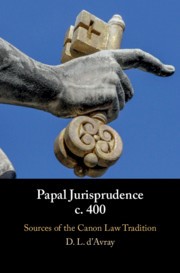
In the late fourth century, in the absence of formal church councils, bishops from all over the Western Empire wrote to the Pope asking for advice on issues including celibacy, marriage law, penance and heresy, with papal responses to these questions often being incorportated into private collections of canon law. Most papal documents were therefore responses to questions from bishops, and not initiated from Rome. Bringing together these key texts, this volume of accessible translations and critical transcriptions of papal letters is arranged thematically to offer a new understanding of attitudes towards these fundamental issues within canon law. Papal Jurisprudence, c.400 reveals what bishops were asking, and why the replies mattered. It is offered as a companion to the forthcoming volume Papal Jurisprudence: Social Origins and Medieval Reception of Canon Law, 385–1234.
Olivier Descamps and Rafael Domingo, Great Christian Jurists in French History (Cambridge Univ. Press, 2019)

French legal culture, from the Middle Ages to the present day, has had an impressive influence on legal norms and institutions that have emerged in Europe and the Americas, as well as in Asian and African countries. This volume examines the lives of twenty-seven key legal thinkers in French history, with a focus on how their Christian faith and ideals were a factor in framing the evolution of French jurisprudence. Professors Olivier Descamps and Rafael Domingo bring together this diverse group of distinguished legal scholars and historians to provide a unique comparative study of law and religion that will be of value to scholars, lawyers, and students. The collaboration among French and non-French scholars, and the diversity of international and methodological perspectives, gives this volume its own unique character and value to add to this fascinating series.
Silvia Di Paolo, Verso la modernità giuridica della Chiesa: Giovanni Francesco Pavini (ca. 1424–1485): la stampa, le decisiones, le extravagantes e la disciplina amministrativa (Rome, 2018)

Racchiusa nel pieno Umanesimo italiano, la vita del canonista padovano Giovanni Francesco Pavini rappresenta una parabola esemplare per osservare come alle soglie dell’età moderna la figura tradizionale del teologo e doctor in utroque iure si arricchisca di nuovi profili, espressioni di una cultura giuridica profondamente rinnovata dai motivi dell’Umanesimo e dagli effetti connessi alla nascita del libro giuridico a stampa. La sua versatilità nella legislazione, nella giurisprudenza, nella dottrina e nell’amministrazione della Chiesa fu il risultato di una vita trascorsa per la prima metà a Padova, dove fu immerso nell’ambiente accademico e nell’amministrazione diocesana, per la seconda a Roma, dove fece parte dell’elitario collegio degli uditori della Sacra Rota e mostrò una precoce tendenza a recepire le istanze di cambiamento di un mondo medievale ormai in crisi. L’importanza dell’introduzione della stampa nella diffusione della cultura giuridica gli parve subito rivoluzionaria e si fece per questo sensibile e appassionato promotore del libro giuridico a stampa attraverso il quale espresse una visione particolarmente moderna dell’ordinamento. Il suo impegno nella raccolta della legislazione extravagans e nella precisazione di un corredo di glosse contribuì in maniera decisiva a determinare la futura fisionomia del Corpus Iuris Canonici; la sistemazione della giurisprudenza rotale e della dottrina consiliare evidenziò il tendenziale valore normativo di queste fonti. La sua riflessione intorno alle regole di cancelleria alla luce delle categorie di diritto comune, che fece emergere la questione della natura generale o particolare della normativa amministrativa, nonché l’analisi sistematica dei meccanismi di governo della chiesa locale sembrano aver segnato un passaggio importante nella lenta precisazione dell’amministrazione come disciplina giuridica all’inizio dell’età moderna.
Anne J. Duggan, Popes, Bishops, and the Progress of Canon Law, c. 1120–1234 (Brepols, 2020)
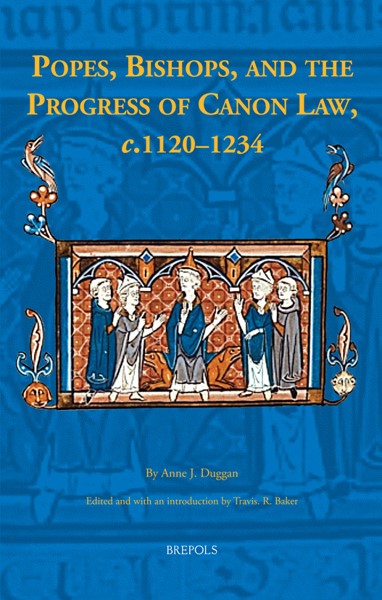
Bishops have always played a central role in the making and enforcement of the law of the Church, and none more so than the bishop of Rome. From convening and presiding over church councils to applying canon law in church courts, popes and bishops have exercised a decisive influence on the history of that law. This book, a selection of Anne J. Duggan’s most significant studies on the history of canon law, highlights the interactive role of popes and bishops, and other prelates, in the development of ecclesiastical law and practice between 1120 and 1234. This emphasis directly challenges the pervasive influence of the concept of “papal monarchy,” in which popes, and not diocesan bishops and their legal advisers, have been seen as the driving force behind the legal transformation of the Latin Church in the twelfth and early thirteenth centuries. Contrary to the argument that the emergence of the papacy as the primary judicial and legislative authority in the Latin Church was the result of a deliberate programme of papal aggrandizement, the principal argument of this book is that the processes of consultation and appeal reveal a different picture: not of a relentless papal machine but of a constant dialogue between diocesan bishops and the papal Curia, in which the “papal machine” evolved to meet the demand.
Lawrence G. Duggan, Armsbearing and the Clergy in the History and Canon Law of Western Christianity (Boydell, 2013)

In the first millennium the Christian Church forbade its clergy from bearing arms. In the mid-eleventh century the ban was reiterated many times at the highest levels: all participants in the battle of Hastings, for example, who had drawn blood were required to do public penance. Yet over the next two hundred years the canon law of the Latin Church changed significantly: the pope and bishops came to authorize and direct wars; military-religious orders, beginning with the Templars, emerged to defend the faithful and the Faith; and individual clerics were allowed to bear arms for defensive purposes. This study examines how these changes developed, ranging widely across Europe and taking the story right up to the present day; it also considers the reasons why the original prohibition has never been restored. Lawrence G. Duggan is Professor of History at the University of Delaware and research fellow of the Alexander von Humboldt Foundation.
Stephan Dusil, Wissensordnungen des Rechts im Wandel: Päpstlicher Jurisdiktionsprimat und Zölibat zwischen 1000 und 1215 (Leuven Univ. Press, 2018)
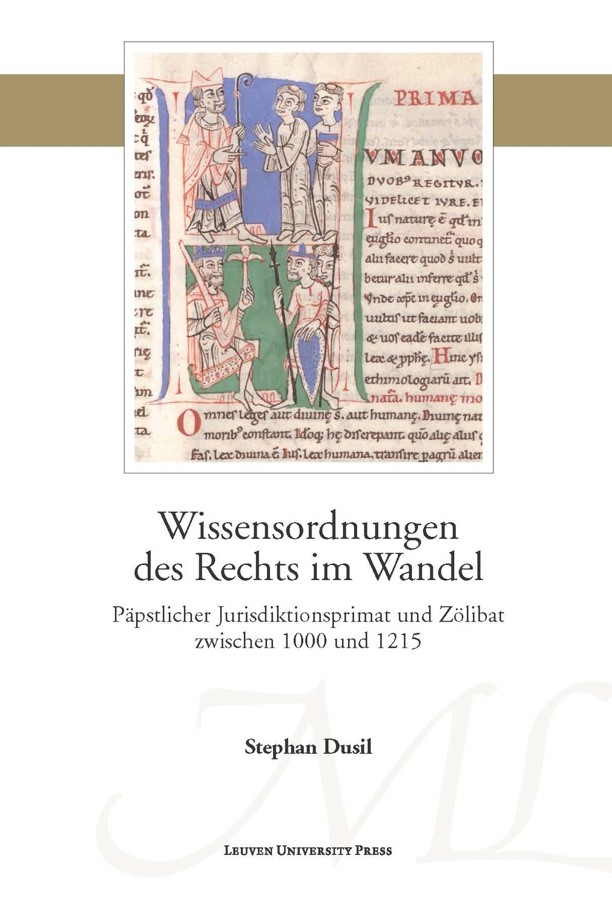
Between 1000 and 1215, the knowledge of canon law changed fundamentally. Although ecclesiastic rules of law had been linearly collected by 1000, they had evolved into complex, highly interlinked carriers of knowledge by 1215. By carefully examining manuscript transmission, this book elucidates the evolution of legal knowledge, taking papal jurisdictional primacy and clerical celibacy as an illustrative example. Furthermore, it shows the influence the artes liberales and rhetoric had on the organisation of canon law. This study thus offers fascinating insights into the origins of canon law as an academic discipline, thereby also demonstrating the diversity and multi-layeredness of legal knowledge in the High Middle Ages.
Péter Erdö, Kornél Szovák, and Péter Tusor, eds., Formularium Ecclesiae Strigoniensis (Budapest, 2018; 2nd ed., 2020)
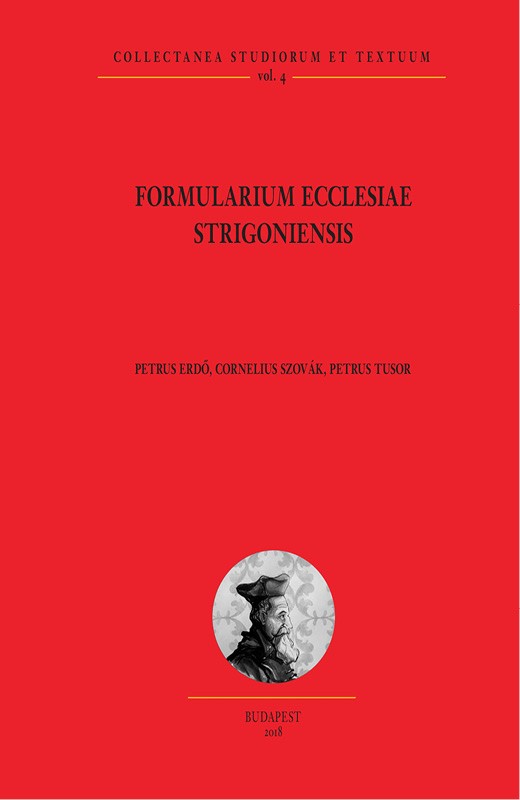
Az Esztergomi Főszékesegyházi Könyvtár őrzi azt a középkor végi formulagyűjteményt, melynek mintakódexe a 18. században Pozsonyon keresztül vezető kalandos úton jutott mai őrzési helyére, a gyulafehérvári Batthyány Ignác püspök alapította Bibliotheca Batthyanyana gyűjteményébe. A két kézirat értelemszerűen egymással is, de főképpen az esztergomi érseki szentszék bírósági működésével áll rendkívül szoros kapcsolatban.
Amikor a 16. század elején a két kódex szövegét megszerkesztették ill. lemásolták, a számos altípust képviselő és számos funkciót betöltő levélmintagyűjtemények szerkesztése nagy múltra tekinthetett már vissza a középkori Magyarországon. Kétségtelen ugyanakkor, hogy az ilyes fajta tevékenység az ösztönzést Itáliától nyerte: az észak-itáliai egyetemek 13. századi magyar hallgatóinak tanulmányaitól kezdve, a 14. század eleji pápai legátusok hivatali tevékenységének mintaadásán keresztül, a 15–16. század fordulója olasz helynökeinek munkálkodásáig bezárólag. Így az elméleti ismeretekre ráépültek a minták, végül a személyes gyakorlat alakította ki a rendszert. A világi és egyházi formuláskönyvek legfontosabb jellemzője kezdettől fogva a helyi bírósági gyakorlat jogrendjének és elveinek az írásban történő rögzítése volt. Ezt ugyan mindenkor befolyásolta a felsőoktatásban elsajátított elméleti joganyag, lényegében a jogszokás volt a bíróságok működésének az alapja, az egyes országok ebben a tekintetben szuverén jogterületnek számítottak. A formuláriumok kezdetei kezdetben partikuláris gyűjteményeket eredményeztek mindkét – a szekuláris és az egyházi – területen, a 15. század végének fejleménye volt a szintézisek megjelenése.
A két kódex – az esztergomi Nyási-gyűjtemény és a gyulafehérvári Beneéthy-kézirat – az egyházi jogéletben ugyanúgy a középkor végi szintézis képviselői, miként a pécsi Magyi-kódex a világi-közjegyzői gyakorlatban. A mintakéziratot 1512 előtt Beneéthy Máté, az esztergomi prímási szentszék jegyzője állította össze expediált iratok összegyűjtése és racionális csonkolása (= űrlapszerűvé tétele) útján, ezt az anyagot ismeretlen jegyző Nyási Demeter érseki helynök irodájában 1521 körül lemásolta, némiképp átszerkesztette, néhány darab elhagyása után számos darabbal kiegészítette. Bár az originális szerkesztőmunka a korábbi (minta)kézirat sajátja, a kiegészített változat a középkori esztergomi egyházkormányzat legteljesebb dokumentációját tartalmazza. Szövegkiadásunk első ízben tesz közzé kritikai kiadásban teljes szövegében egyházkormányzati kézikönyvet. Az editio alapját a Nyási-kódex képezi, apparátusa és függeléke ugyanakkor lehetővé teszi a mintakódex szövegállományának megismerését is. Mivel sem a Beneéthy-kódex, sem a Nyási-verzió önmagában nem hibátlan, a két változat folyamatos szem előtt tartásával a kiadók kísérletet tettek a Stylus Strigoniensis középkor végi rekonstrukciójára, a kérdéses helyek mélyreható mérlegelése útján hozták meg döntésüket a kínálkozó lehetőségek kérdésében. A kiadás ily módon a klaszszika-filológiában kimunkált szövegkonstrukciós gyakorlatot követi, ugyanakkor a többszintű apparátus segítségével a két kézirat teljes szövege nehézség nélkül megismerhető belőle, ezeket tárja minimális történeti kommentárok kíséretében az olvasók elé, feltüntetve a párhuzamos helyeket és a nyomtatásban korábban napvilágot látott kivonatokat is.
A szöveg beható tanulmányozása lehetővé teszi, hogy a használó megismerje az egyházkormányzat késő középkori mindennapjait, az egyházi bíráskodás gyakorlatát, a zsinattartás rendjét, a vizitációs ellenőrző tevékenység módszereit és körülményeit, a lelkészkedő papsággal kapcsolatban felmerülő kérdéseket, a szerzetesi reform bonyolult összefüggéseit, a hívek ügyes-bajos szentszéki dolgait (végrendelet, kölcsön, kegyes adomány, búcsúnyerés, koldulási engedély, kiközösítés, feloldozás stb.), végezetül a liturgikus gyakorlat főbb kérdéseit. A színes kép a teljesség igényét is kielégíti, alig gondolható el olyan téma az egyházi élet területéről, melynek mintalevelét ne vették volna fel az összeállítók a gyűjteményekbe. A későbbiekben a szövegkötethez részletes kommentárkötet írását tervezik a szerzők, továbbá a helynöki tevékenység köréből korunkra maradt eredeti dokumentumok összegyűjtését és a mintagyűjteménnyel való szembesítését.
Arnaud Fossier, Le bureau des âmes: écritures et pratiques administratives de la Pénitencerie apostolique (XIIIe-XIVe siècle) (Rome, 2018)

Ce livre est le résultat d’une enquête menée sur les archives les plus anciennes d’une institution originale et mal connue : la Pénitencerie apostolique. Né au tout début du XIIIe siècle dans le giron d’une papauté exerçant son pouvoir sur tout l’Occident latin, ce nouvel office fut d’abord chargé d’entendre en confession les pèlerins qui se rendaient à Rome pour demander l’absolution de leurs péchés. Puis il se vit mandaté pour répondre aux suppliques qui, chaque jour, étaient adressées au souverain pontife. L’enquête s’appuie donc sur les « formulaires » voués à recueillir, réordonner et abréger les milliers de lettres que la Pénitencerie expédiait en réponse aux suppliants. Véritables répertoires d’exemples, dans lesquels la forme et la norme étaient indissociables, ces manuels reflètent tous les cas de figure auxquels pouvait être confrontée la Pénitencerie : homicides, naissances illégitimes, mariages incestueux, faux et usage de faux, moines ayant fui leurs couvents, etc. À tous ces suppliants, le tribunal du pape avait la charge d’octroyer des dispenses, des licences ou des absolutions, parfois dans le secret du « for de la confession ». Situé au croisement d’une histoire des pratiques de l’écrit et de l’avènement des bureaucraties, du gouvernement pastoral et de la souveraineté pontificale, de la confession auriculaire et de l’espace public, ce livre entend dépasser le cadre classique de la monographie institutionnelle.
Arnaud Fossier, Dominique Le Page, and Bruno Lemesle, eds., La représentation politique et ses instruments avant la démocratie (Dijon, 2020)
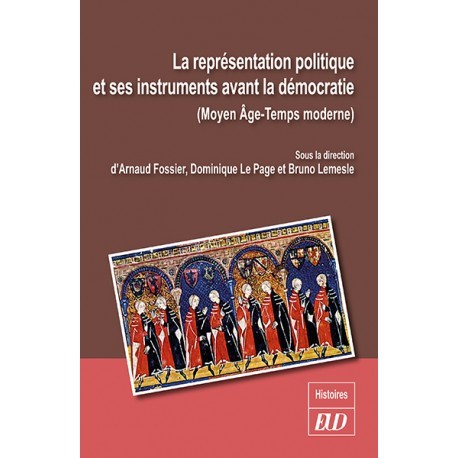
L’objectif de l’ouvrage est de proposer une enquête sur la représentation politique dans les sociétés médiévales et d’Ancien Régime, avant que n’émerge, au XVIIIe siècle, l’idée d’un « peuple souverain » et d’un gouvernement représentatif. Par delà la diversité des lieux institutionnels étudiés et des acteurs évoqués, ressortent de cette enquête la force et la pérennité de certains instruments de représentation. Dès le XIIIe siècle, les formes de délégation du pouvoir et les pratiques d’assemblée ont en effet reposé sur le même type d’instruments juridiques (lettres de provision, de commission, d’instruction ou de convocation). Cet ouvrage montre qu’il n’est plus possible de faire l’histoire des théories modernes de la représentation sans les articuler aux pratiques elles-mêmes. Se pose en effet désormais la question de l’efficacité des instruments de représentation, des usages parfois détournés qui en furent faits et des résistances qui leur furent opposées, jusqu’à ce que vienne le temps des assemblées se réclamant du peuple.
Arnaud Fossier, Johann Petitjean, and Clémence Revest, eds., Écritures grises: les instruments de travail des administrations (XIIe‑XVIIe siècles) (Paris, 2019)

Ce livre est le fruit d’une enquête collective autour de la genèse de l’administration en Europe, entre construction de l’État « moderne » et « révolution » de l’écrit. Il invite à quitter le devant de la scène politique pour en visiter les coulisses ; à détacher le regard des ors du pouvoir pour s’intéresser à la part grise de l’action administrative, à ses instruments et ses techniques documentaires. On trouvera ici une série d’études de cas, encadrées par deux textes qui interrogent les seuils chronologiques de cette histoire. Toutes portent sur les pratiques administratives des différents pouvoirs européens entre le xiiᵉ et le xviiᵉ siècle (communes, seigneuries, évêchés, papauté, royautés, principautés ou Empire). La première partie, intitulée « Règles, formes et modèles d’écriture administrative », aborde la question de la matrice notariale des administrations médiévales, de leur style et de leur langue. La deuxième partie identifie plusieurs « logiques de production documentaire » caractéristiques des administrations du Moyen Âge et de la première modernité : constitution de dossiers, de listes, d’inventaires ou de questionnaires. Dans une troisième et dernière partie, « Circulations et jeux d’échelle », ce sont les territoires de l’action administrative qui sont explorés, et par là-même la diffusion de modèles, d’instruments et de pratiques, au niveau local ou régional, comme à l’échelle globale. À partir d’une nouvelle catégorie d’analyse, les « écritures grises », et d’un large terrain d’observation et de comparaison qui fait apparaître une Europe méditerranéenne ouverte à d’autres espaces (Saint-Empire, Flandre, Nouveau Monde, Pays-Bas espagnols), ce livre propose une approche inédite du fait administratif.
Derek Hill, Inquisition in the Fourteenth Century: The Manuals of Bernard Gui and Nicholas Eymerich (Heresy and Inquisition in the Middle Ages) (York, 2019)

The Inquisition played a central role in European history. It moulded societies by enforcing religious and intellectual unity; it helped develop the judicial and police techniques which are the basis of those used today; and it helped lay the foundations for the persecution of witches. An understanding of the Inquisition is therefore essential to the late medieval and early modern periods.
This book looks at how the philosophy and practice of Inquisition developed in the fourteenth century. It saw the proliferation of heresies defined by the Church (notably the Spiritual Franciscans and Beguines) and the classification of many more magical practices as heresy. The consequential widening of the Inquisition’s role in turn led to it being seen as an essential part of the Church and the guardian of all the Church’s doctrinal boundaries; the inclusion of magic in particular also changed the Inquisition’s attitude towards suspects, and the use of torture became systematised and regularised.
These changes are charted here through close attention to the inquisitorial manuals of Bernard Gui and Nicholas Eymerich, using other sources where available. Gui’s and Eymerich’s personalities were important factors. Gui was a successful insider, Eymerich a maverick, but Eymerich’s work had the greater long-term influence. Through them we can see the Inquisition in action.
Henry Ansgar Kelly, The Middle English Bible: A Reassessment (Univ. of Pennsylvania Press, 2016)

In the last quarter of the fourteenth century, the complete Old and New Testaments were translated from Latin into English, first very literally, and then revised into a more fluent, less Latinate style. This outstanding achievement, the Middle English Bible, is known by most modern scholars as the “Wycliffite” or “Lollard” Bible, attributing it to followers of the heretic John Wyclif. Prevailing scholarly opinion also holds that this Bible was condemned and banned by the archbishop of Canterbury, Thomas Arundel, at the Council of Oxford in 1407, even though it continued to be copied at a great rate. Indeed, Henry Ansgar Kelly notes, it was the most popular work in English of the Middle Ages and was frequently consulted for help in understanding Scripture readings at Sunday Mass.
In The Middle English Bible: A Reassessment, Kelly finds the bases for the Wycliffite origins of the Middle English Bible to be mostly illusory. While there were attempts by the Lollard movement to appropriate or coopt it after the fact, the translation project, which appears to have originated at the University of Oxford, was wholly orthodox. Further, the 1407 Council did not ban translations but instead mandated that they be approved by a local bishop. It was only in the early sixteenth century, in the years before the Reformation, that English translations of the Bible would be banned.
Osvaldo Cavallar and Julius Kirshner, Jurists and Jurisprudence in Medieval Italy: Texts and Contexts (Univ. of Toronto Press, 2020)
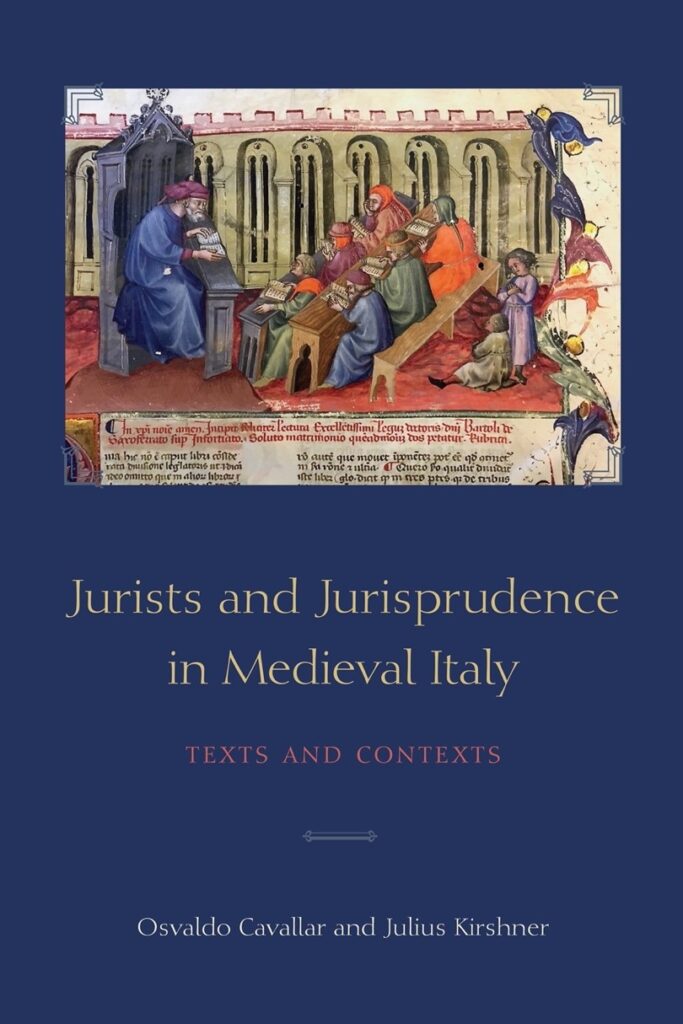
Jurists and Jurisprudence in Medieval Italy is an original collection of texts exemplifying medieval Italian jurisprudence, known as the ius commune. Translated for the first time into English, many of the texts exist only in early printed editions and manuscripts. Featuring commentaries by leading medieval civil law jurists, notably Azo Portius, Accursius, Albertus Gandinus, Bartolus of Sassoferrato, and Baldus de Ubaldis, this book covers a wide range of topics, including how to teach and study law, the production of legal texts, the ethical norms guiding practitioners, civil and criminal procedures, and family matters.
The translations, together with context-setting introductions, highlight fundamental legal concepts and practices and the milieu in which jurists operated. They offer entry points for exploring perennial subjects such as the professionalization of lawyers, the tangled relationship between law and morality, the role of gender in the socio-legal order, and the extent to which the ius commune can be considered an autonomous system of law.
Atria A. Larson, Gratian’s Tractatus de penitentia: A New Latin Edition with English Translation (Catholic Univ. of America Press, 2016)
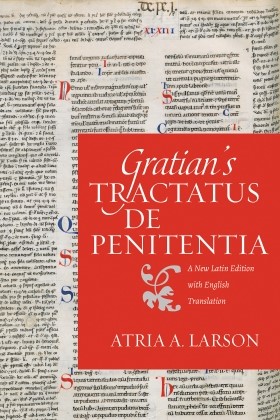
Gratian’s Decretum is one of the major works in European history, a text that in many ways launched the field of canon law. In this new volume, Atria Larson presents to students and scholars alike a critical edition of De penitentia (Decretum C.33 q.3), the foundational text on penance, both for canon law and for theology, of the twelfth century. This edition takes into account recent manuscript discoveries and research into the various recensions of Gratian’s text and proposes a model for how a future critical edition of the entire Decretum could be formatted by offering a facing-page English translation. This translation is the first of this section of Gratian’s De penitentia into any modern language and makes the text accessible to a wider audience. Both the Latin and the English text are presented in a way to make clear the development of Gratian’s text in various stages within two main recensions. The edition and translation are preceded by an introduction relating the latest scholarship on Gratian and his text and are followed by three appendices, including one that provides a transcription of the relevant text from the debated manuscript Sankt Gallen, Stiftsbibliothek 673, and one that lists possible formal sources and related contemporary texts. This book provides a full edition and translation of the text studied in depth in Master of Penance: Gratian and the Development of Penitential Thought and Law in the Twelfth Century (CUA Press, 2014) by the same author.
Atria A. Larson and Andrea Massironi, eds., The Fourth Lateran Council and the Development of Canon Law and the ius commune (Brepols, 2018)
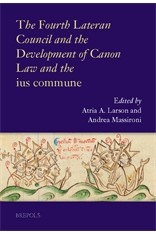
This volume collects essays from an international group of scholars who treat various aspects of the Fourth Lateran Council’s placement within the development of the ius commune. Topics include the canon law about armsbearing clergy, episcopal elections, heresy, degrees of affinity within marriage, the oversight of relic veneration; two essays highlight the council’s reaction to the Fourth Crusade’s sack of Constantinople in trying to incorporate the eastern church into the ecclesiastical structure and liturgical norms of the Roman Church; several essays concentrate on the usage of Roman or civil law in some of Lateran IV’s constitutions and emphasize issues of private and procedural law. Collectively, and headed by an essay by Anne J. Duggan on the relationship of Pope Alexander III’s pontificate to the Lateran IV constitutions, the essays create a fuller picture of Innocent III and his curia’s reliance on developments within the jurisprudence of the preceding half century, but they also reveal the ways in which they forged new paths and made significant contributions to guide canon law in the years following the council.
Contributors are: Anne J. Duggan, Lawrence G. Duggan, Thomas M. Izbicki, Steven A. Schoenig, SJ, Fabrice Delivré, Giles Constable, Vito Piergiovanni, Alejandro Morin, Christine Oakland, Anthony Perron, Piotr Alexandrowicz, Łukasz Jan Korporowicz, Andrea Massironi, and Giovanni Chiodi.
Keith Sisson and Atria A. Larson, eds., A Companion to the Medieval Papacy: Growth of an Ideology and Institution (Brill, 2016)
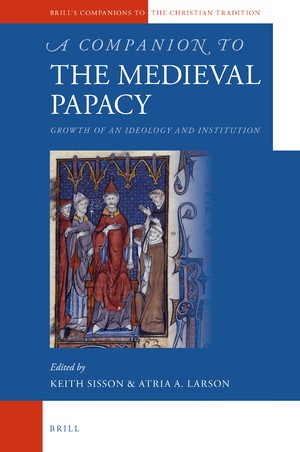
A Companion to the Medieval Papacy brings together an international group of experts on various aspects of the medieval papacy. Each chapter provides an up-to-date introduction to and scholarly interpretation of topics of crucial importance to the development of the papacy’s thinking about its place in the medieval world and of its institutional structures.
Topics covered include: the Papal States; the Gregorian Reform; papal artistic self-representation; hierocratic theory; canon law; decretals; councils; legates and judges delegate; the apostolic camera, chancery, penitentiary, and Rota; relations with Constantinople; crusades; missions. The volume includes an introductory chapter by Thomas F.X. Noble on the historiographical challenges of writing medieval papal history.
Contributors are: Sandro Carocci, Atria A. Larson, Andrew Louth, Jehangir Malegam, Andreas Meyer, Harald Müller, Thomas F.X. Noble, Francesca Pomarici, Rebecca Rist, Kirsi Salonen, Felicitas Schmieder, Keith Sisson, Danica Summerlin, and Stefan Weiß.
Bruno Lemesle,Quand l’Église corrigeait les excès du clergé: la punition des délits ecclésiastiques au Moyen Âge (Dijon, 2018)

L’Église catholique d’aujourd’hui aurait-elle renoncé à corriger les abus du clergé? Non, bien sûr, et elle reste d’ailleurs héritière de cette époque ancienne: quand sévissait la « correction des excès ». Cet ouvrage poursuit un double objectif. Tout d’abord, il veut faire état des recherches actuelles consacrées à l’accroissement brusque de la dénonciation des excès dans le clergé et chez les laïcs et montrer l’exigence de leur correction à partir du XIIe siècle. Le second objectif est de mettre la situation contemporaine en regard du contexte du Moyen Âge. Aujourd’hui, dans le Vieux continent et en Amérique du nord, l’Église ne parvient plus à modeler les comportements ni à susciter l’adhésion à son dogme. De ce point de vue, notre époque s’oppose aux derniers siècles du Moyen Âge, quand l’Église était au faîte de sa puissance et que triomphait son idéologie. L’écart entre les deux est non seulement saisissant, mais historiquement inédit. Cet essai offre de nouvelles pistes de réflexion qui permettent de mieux évaluer la situation présente. Il apporte ainsi sa contribution à des questions devenues presque lancinantes: un aggiornamento de l’Église serait-il la bonne réponse à son déclin? L’Église catholique peut-elle transiger sur la doctrine?
David von Mayenburg, Orazio Condorelli, Franck Roumy, and Mathias Schmoeckel, eds., Der Einfluss der Kanonistik auf die europäische Rechtskultur: Bd. 5, Das Recht der Wirtschaft (Norm und Struktur) (Köln, 2016)
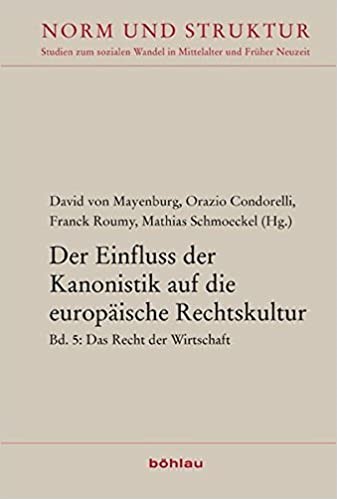
Die hier versammelten Beiträge von Kanonisten aus fünf Ländern belegen die pragende Leistung des kanonischen Rechts für die wirtschaftsnahen Gebiete der heutigen Rechtsordnung. Abseits des bekannten kanonischen Zinsverbots wurden erfinderisch und differenziert Vorgaben dafür entwickelt, welche Vertragsgestaltung als gerecht, welcher Schutz des Verbrauchers als angemessen gelten und welche legitimen Interessen die Wirtschaft vertreten durfte. Diskutiert wurden die legitimen Einnahmen, die Finanzverwaltung und die Konzeption des Geldes. In kondensierter Form führt dieser Band vor, wie sehr sich der ökonomische Aufstieg Europas den Vorstellungen der Kirchenjuristen verdankt.
John S. Ott, Bishops, Authority and Community in Northwestern Europe, c.1050–1150 (Cambridge Univ. Press, 2015)
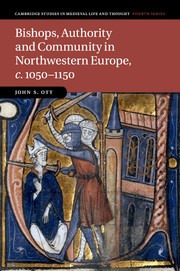
This important study of episcopal office and clerical identity in a socially and culturally dynamic region of medieval Europe examines the construction and representation of episcopal power and authority in the archdiocese of Reims during the sometimes turbulent century between 1050 and 1150. Drawing on a wide range of diplomatic, hagiographical, epistolary and other narrative sources, John S. Ott considers how bishops conceived of, and projected, their authority collectively and individually. In examining episcopal professional identities and notions of office, he explores how prelates used textual production and their physical landscapes to craft historical narratives and consolidate local and regional memories around ideals that established themselves as not only religious authorities but also cultural arbiters. This study reveals that, far from being reactive and hostile to cultural and religious change, bishops regularly grappled with and sought to affect, positively and to their advantage, new and emerging cultural and religious norms.
Radosław Kotecki, Jacek Maciejewski, and John S. Ott, eds., Between Sword and Prayer: Warfare and Medieval Clergy in Cultural Perspective (Brill, 2017)
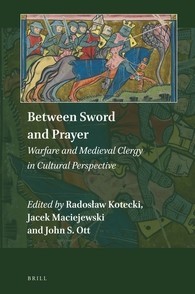
Between Sword and Prayer is a broad-ranging anthology focused on the involvement of medieval clergy in warfare and a variety of related military activities. The essays address, on the one hand, the issue of clerical participation in combat, in organizing military campaigns, and in armed defense, and on the other, questions surrounding the political, ideological, or religious legitimization of clerical military aggression. These perspectives are further enriched by chapters dealing with the problem of the textual representation of clergy who actively participated in military affairs. The essays in this volume span Latin Christendom, encompassing geographically the four corners of medieval Europe: Western, East-Central, Northern Europe, and the Mediterranean.
Contributors are: Carlos de Ayala Martínez, Geneviève Bührer-Thierry, Chris Dennis, Pablo Dorronzoro Ramírez, Lawrence G. Duggan, Daniel Gerrard, Robert Houghton, Carsten Selch Jensen, Radosław Kotecki, Jacek Maciejewski, Ivan Majnarić, Monika Michalska, Michael Edward Moore, Craig M. Nakashian, John S. Ott, Katherine Allen Smith, and Anna Waśko.
Andrea Padovani, Dall’alba al crepusculo del commento: Giovanni da Imola (1375 ca.-1436) e la giurisprudenza del suo tempo (Frankfurt, 2016)
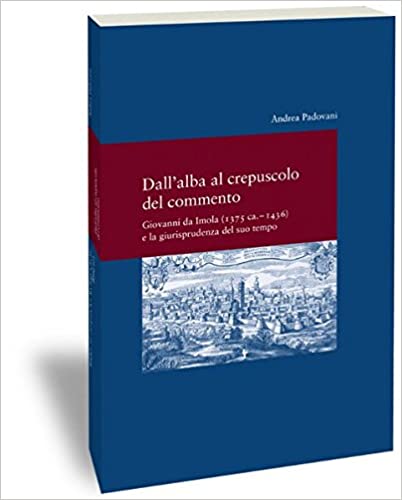
Lange Zeit als einer der wichtigsten Juristen des europäischen ius commune gepriesen, wurde Giovanni Nicoletti da Imola (ca. 1375 – 1436) selbst zum Ziel der scharfen Kritik an der gesamten Schule der Kommentatoren, zunächst durch die Humanisten und dann durch die Rechtshistoriker, die sich dem negativen Urteil Savignys anschlossen. Das Buch rekonstruiert die verflochtene und nahezu unbekannte Biographie dieses iuris utriusque doctor, seine wissenschaftliche Produktion, sowohl in gedruckter Form (die durch eine eklatante, verlegerische Fälschung belastet war) als auch seine Handschriften sowie die Beziehungen zu seinen Lehrern, Schülern und Kollegen während des Großen Schismas. Als anerkannter und an den wichtigsten Universitäten gefragter Dozent ist Giovanni vor allem Zeuge des dramatischen Übergangs vom Mittelalter zur Neuzeit.
Celebrato, per molto tempo, come uno dei maggiori giuristi del ius commune europeo, Giovanni Nicoletti da Imola (1375 ca. – 1436) subì le critiche roventi pronunciate sull’intera scuola del commento prima dagli umanisti e poi dagli storici del diritto allineati al giudizio negativo di Savigny. Questo saggio ricostruisce finalmente l’intricata, quasi sconosciuta biografia di questo iuris utriusque doctor, la sua produzione scientifica sia a stampa (viziata da un clamoroso falso editoriale) che manoscritta, i rapporti con i maestri, i discepoli e i colleghi negli anni del Grande Scisma. Docente affermato e conteso dalle maggiori università del suo tempo, Giovanni è soprattutto un testimone della drammatica transizione dal medioevo all’età moderna.
Andrea Padovani, Quadri da una esposizione canonistica (Venice, 2019)

The idea of this book is to accompany those approaching the history of canon law for the first time in the same way as a guide with one-day visitors in a large picture gallery. In the impossibility of seeing everything, only a few paintings were selected, at least the most famous and important, illustrating the personality of each author, his time, the message transmitted, the influence exerted on others who followed. In the hope that, at the end of even a brief visit, the desire to return again will arise, deepening their knowledge of a world that, before, they did not know at all.
Mathias Schmoeckel, Franck Roumy, and Orazio Condorelli, eds., Der Einfluss der Kanonistik auf die europäische Rechtskultur: Bd. 6, Völkerrecht (Norm und Struktur) (Köln, 2020)
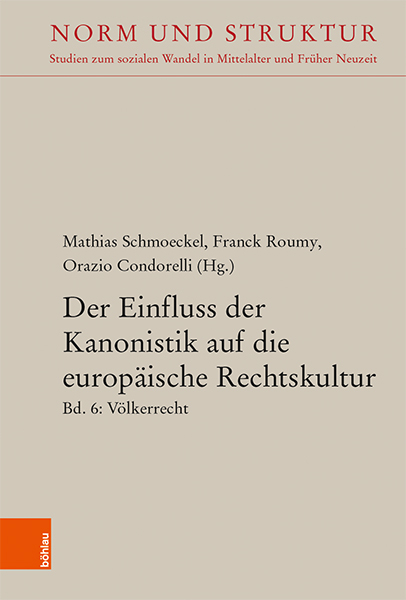
Dieser Band widmet sich dem Recht der internationalen Beziehungen im europäischen Recht des Mittelalters in Krieg und Frieden. Hier wurden die Grundlagen für die Gültigkeit von Verträgen, die Behandlung von Staatsangehörigen wie auch von Migranten gelegt.
Längst bevor es das Völkerrecht als Fach gab, wurden etwa das Recht zu Verhandlungen zwischen unabhängigen Stadtstaaten, zum Abschluss und der Wiederauflösung von (internationalen) Verträgen oder zum Durchzugsrecht von Heeren international wie national diskutiert. Das gleiche gilt auch für die Erörterung von Mindeststandards im internationalen Umgang mit Menschen als sogenanntes »ius humanitatis«. Ebenso werden dort die Rechte von Migranten behandelt wie Fragen der Staatsangehörigkeit oder Regeln für den Krieg. Auch wird deutlich, warum Europa den Kriegsgrund des »Heiligen Krieges« im Ergebnis ablehnte. An diesen Themen zeigt sich beispielhaft die allgemeine Entwicklung zu einer spezifisch völkerrechtlichen Literatur. Damit füllt der Band eine große Forschungslücke.
Mathias Schmoeckel, Kanonisches Recht: Geschichte und Inhalt des Corpus iuris canonici (München, 2020)

Das klassische kanonische Recht ist nicht nur das Recht, das innerhalb des ersten Jahrtausends in der Auseinandersetzung mit dem römischen Recht zum Recht der mittelalterlichen Kirche wurde. Es enthält vielmehr die Regeln, die in den nachfolgenden Jahrhunderten zur Grundlage der europäischen Rechtsordnung sowie der europäischen Staaten wurde. Hier entwickelten sich die Grundlagen. Das klassische kanonische Recht prägt die Rechtsvorstellungen vielfach bis heute.
Steven A. Schoenig, SJ, Bonds of Wool: The Pallium and Papal Power in the Middle Ages (Catholic Univ. of America Press, 2016)

In the pallium the medieval papacy created a mechanism of control over the far-flung bishops of the Latin church, a prerogative by which the popes shared honor and power with local prelates—and simultaneously wielded power over them. Contributing to the sway and oversight of the Roman church, this vestment became part of the machinery of centralization that helped produce the high medieval papal monarchy.
The pallium was effective because it was a gift with strings attached. This band of white wool encircling the shoulders had been a papal insigne and liturgical vestment since late antiquity. It grew in prominence when the popes began to bestow it regularly on other bishops as a mark of distinction and a sign of their bond to the Roman church. Bonds of Wool analyzes how, through adroit manipulation, this gift came to function as an instrument of papal influence. It explores an abundant array of evidence from diverse genres—including chronicles and letters, saints’ lives and canonical collections, polemical treatises and liturgical commentaries, and hundreds of papal privileges—stretching from the eighth century to the thirteenth and representing nearly every region of Western Europe. These sources reveal that the papal conferral of the pallium was an occasion for intervening in local churches throughout the West and a means of examining, approving, and even disciplining key bishops, who were eventually required to request the pallium from Rome.
The history of the pallium provides an enlightening window on medieval culture. Through it one can perceive how medieval society expressed beliefs and relationships through artifacts and customs, and one can retrieve the aims and attitudes underlying medieval rituals and symbols. Following the story of this simple material object sheds light on some of the ways medieval people structured their society, exercised authority, and communicated ideas and values.
Thierry Sol, Droit subjectif ou droit objectif? la notion de ius en droit sacramentaire au XIIe siècle (Brepols, 2017)
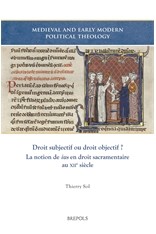
Michel Villey situait le passage d’une conception réaliste à une conception subjective du droit (le droit conçu comme pouvoir de l’individu) au XIVe siècle, lors de la controverse sur la pauvreté franciscaine et du développement de la philosophie volontariste d’Ockham. Brian Tierney remit en cause cette hypothèse et rechercha les prodromes de la notion de droits naturels (rights,par opposition au droit objectif et positif, laws) dès le XIIe siècle. Michel Villey signalait lui aussi l’importance du XIIe siècle, mais y voyait au contraire la renaissance de la notion réaliste de droit, à la faveur de la redécouverte du droit romain et du développement de la jurisprudence. Pour trancher cette controverse entre ces deux grands historiens et philosophes du droit, il convenait de retourner aux textes.
Peut-on trouver dès le XIIe siècle les germes d’une conception subjective du droit? En s’interrogeant sur la validité et la licéité des sacrements célébrés par les clercs hérétiques, schismatiques ou simoniaques, le cas des ordinations absolues et le pouvoir de lier et délier des prélats hérétiques, le droit sacramentaire offre un champ d’analyse privilégié. Dans ces situations se trouve problématisé le rapport entre la situation personnelle du ministre (à la fois morale et canonique) et sa fonction au service de l’Église, c’est-à-dire entre une situation subjective de «possession personnelle» du sacrement de l’ordre et une situation de distribution des sacrements au service de la communauté des fidèles.
Gratien puis Roland, Rufin, Étienne de Tournai, Jean de Faenza, Simon de Bisignano, Huguccio et les Summae (parisiensis, coloniensis, lipsiensis, etc.) utilisent certes un vocabulaire subjectivement façonné (potestas, potentia, facultas, ius dandi), mais derrière les mots se développe une conception objective du droit, seule capable de fournir des distinctions opérantes aux questions pratiques d’un siècle crucial pour le droit canonique.
Mary E. Sommar, The Slaves of the Churches: A History (Oxford Univ. Press, 2020)

In recent years, stories of religious universities and institutions grappling with their slave-owning past have made headlines in the news. People find it shocking that the Church itself could have been involved in such a sordid business. This timely book, the result of many years of research, is a study of the origins of this problem.
Mary E. Sommar examines how the church sought to establish norms for slave ownership on the part of ecclesiastical institutions and personnel, and for others’ behavior towards such slaves. The story begins in the New Testament era, when the earliest Christian norms were established, and continues up to thirteenth-century establishment of a body of canon law that would persist into the twentieth century. Along with her analysis of the various policies and statutes, Sommar draws on chronicles, letters, and other documents from each of the various historical periods to provide insight into the situations of unfree ecclesiastical dependents. She finds that unfree dependents of the Church actually had less chance of achieving freedom than did the slaves of other masters. The church authorities’ duty to preserve the Church’s patrimony for the needs of future generations led them to hold on tightly to their unfree human resources. This accessibly written book does not present an apology for the behavior of past Christian leaders, but attempts to learn what they did and to arrive at some understanding of why they made those choices.
Rosalba Sorice, Vittime colpevoli e colpevoli innocenti: ricerche sulle responsabilità penali nell’età del diritto comune (Bologna, 2017)
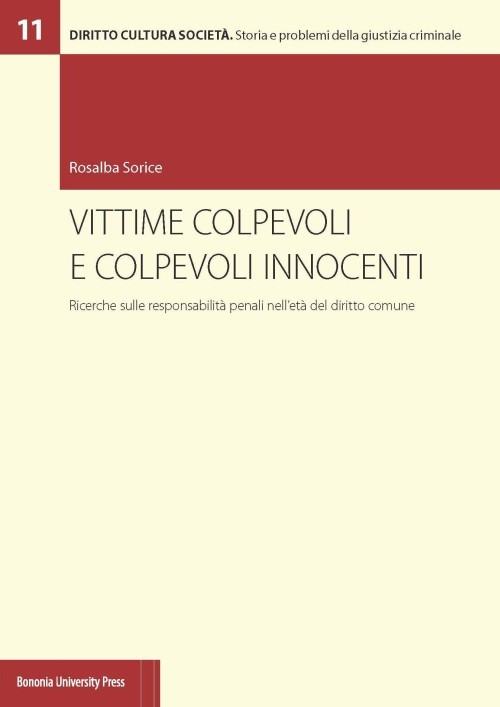
The theoretical elaborations of the scientia iuris starting from the twelfth century have contributed in a decisive way to the difficult and complex work of constructing principles that support the slow emergence of substantive criminal law. In a time still marked by the vindictive perspective that structures the sphere of responsibility on the occurrence of facts, which has its roots in the early medieval customs of responding to the offense with an offense, medieval jurists committed to building rules for the trial and to shape the new and changing demands coming from a political and social reality in continuous transformation, they question themselves on substantial aspects that affect sensitive and complex issues of criminal responsibility. Starting from the twelfth century, the slow work of clearing the sources, flanked by the spread of Christian ideals and the law of the Church, led jurists to fill with contents the attribution of responsibility to those who commit a crime, in particular a murder. The doctores soon understand that the indiscriminate administration of corporal punishment to the guilty of such a serious crime does not meet the dimension of voluntariness that begins to mark the yardstick for attributing the criminal act to its executor. In this context, the rules that offer the figure de iure on which to start building a new dimension of criminal responsibility are those that admit the killing of adulterers, also used by jurists to justify the murder of bandits and rebels. Attempts to give meaning to a murder committed with impunity soon led the doctores to construct the substantial profile of the sphere opposite to the voluntary dimension of human responsibility, the sphere of the involuntary. This research is dedicated to this interpretative effort, spanning the middle centuries, centuries of transition and passage from the feudal world to the modern world.
Till Stüber, The Incriminated Bishop: Kings in Conflict with Church Leaders in Visigothic and Frankish Gaul (466–614) (De Gruyter, 2020)
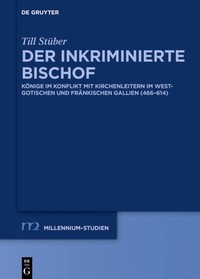
Gallo-römische Bischöfe und ihr wachsender Einfluss während Spätantike und Frühmittelalter haben in der Forschung seit einiger Zeit Konjunktur. Während bisherige Arbeiten dabei zumeist auf verschiedene Gesichtspunkte bischöflicher Autorität abzielten, nimmt Till Stüber solche Situationen in den Blick, in denen bischöfliche Macht herausgefordert wurde und an ihre Grenzen stieß. In seiner Untersuchung zu Loyalitätskonflikten zwischen Bischöfen und Königen geht er zum einen der Frage nach, welche politischen und sozialen Konstellationen für das Aufkommen der Konflikte verantwortlich waren. Zum anderen untersucht er, wie die Zeitgenossen mit den Konfliktsituationen umgingen. Dabei zeigt sich, dass durch die Austarierung der Zuständigkeitsbereiche der königlichen und bischöflichen Gerichtsbarkeit konkrete Mechanismen entwickelt wurden, die den beteiligten Akteuren eine einvernehmliche Beilegung der Auseinandersetzungen in Aussicht stellten. Indem bewusst darauf verzichtet wird, die Thematik aus einer klassisch-verfassungsgeschichtlichen Perspektive zu betrachten, und statt dessen auf die historischen Akteure fokussiert wird, verspricht die Untersuchung neue und grundsätzliche Einblicke in das Verhältnis von Königtum und Episkopat.
Danica Summerlin, The Canons of the Third Lateran Council of 1179: Their Origins and Reception (Cambridge Univ. Press, 2019)

Alexander III’s 1179 Lateran Council, was, for medieval contemporaries, the first of the great papal councils of the central Middle Ages. Gathered to demonstrate the renewed unity of the Latin Church, it brought together hundreds of bishops and other ecclesiastical dignitaries to discuss and debate the laws and problems that faced that church. In this evaluation of the 1179 conciliar decrees, Danica Summerlin demonstrates how these decrees, often characterised as widespread and effective ecclesiastical legislation, emerged from local disputes which were then subjected to a period of sifting and gradual integration into the local and scholarly consciousness, in exactly the same way as other contemporary legal texts. Rather than papal mandates that were automatically observed as a result of their inherent papal authority, therefore, Summerlin reveals how conciliar decrees should be viewed as representative of contemporary discussions between the papacy, their representatives and local bishops, clerics, and scholars.
Szabolcs Anzelm Szuromi and Nicolás Álvarez de las Asturias, eds., Becoming a Priest: Canonical Discipline and Criteria on Suitability for Candidates (Aus Religion und Recht) (Berlin, 2019)
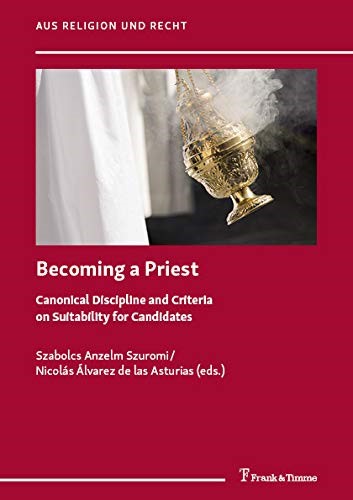
Becoming a Priest focuses on the period between the establishment of the Church by Christ and the middle of the 12th century, when the ecclesiastical discipline necessary to preserve the original meaning, purpose and duties of sacred ministers was stablished. The belief that the Holy Order is received ‘as a gift’ obliges the Church to respect and protect the integrity of the ministry. Sources show how the non- obligatory nature and the high moral requirements of the priesthood guaranteed, ever more seriously, a person’s suitability to every degree of the Holy Order. Gratian’s Decretum (12th c.) already gives a well-balanced and thought-out explication of the qualities of the applicants for, the formation of, and the degrees of the sacred ministry, including the roles of bishops and priests to recognize, select and train those who feel themselves called to the priesthood, and have been be found suitable by the Church authorities. The Decretum Gratiani summarizes the essential basis for determining who is ‘worthy’ to receive the ministry of Christ, and has been held as the authority in this regard for subsequent centuries. This present volume is the first extensive, and published, fruit of the International Canon Law History Research Center (Pázmány Péter Catholic University, Budapest). The primary aim of this center is to produce precise and accessible publications based on extensive research of sources and auxiliary materials. Our purpose is to make possible objective interpretation of those doctrinal and disciplinary texts which have emerged throughout the life and activity of the Church.